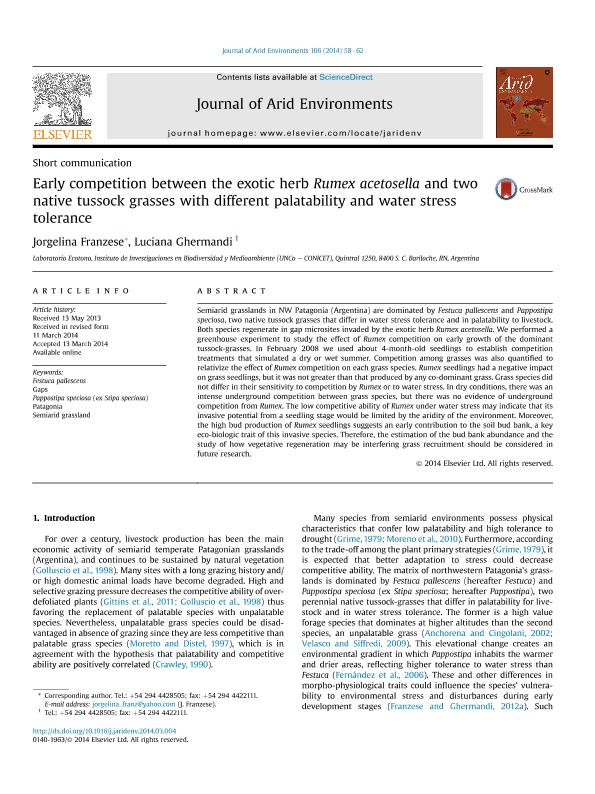Artículo
Early competition between the exotic herb Rumex acetosella and two native tussock grasses with different palatability and water stress tolerance
Fecha de publicación:
07/2014
Editorial:
Elsevier
Revista:
Journal of Arid Environments
ISSN:
0140-1963
Idioma:
Inglés
Tipo de recurso:
Artículo publicado
Clasificación temática:
Resumen
Semiarid grasslands in NW Patagonia (Argentina) are dominated by Festuca pallescens and Pappostipa speciosa, two native tussock grasses that differ in water stress tolerance and in palatability to livestock. Both species regenerate in gap microsites invaded by the exotic herb Rumex acetosella. We performed a greenhouse experiment to study the effect of Rumex competition on early growth of the dominant tussock-grasses. In February 2008 we used about 4-month-old seedlings to establish competition treatments that simulated a dry or wet summer. Competition among grasses was also quantified to relativize the effect of Rumex competition on each grass species. Rumex seedlings had a negative impact on grass seedlings, but it was not greater than that produced by any co-dominant grass. Grass species did not differ in their sensitivity to competition by Rumex or to water stress. In dry conditions, there was an intense underground competition between grass species, but there was no evidence of underground competition from Rumex. The low competitive ability of Rumex under water stress may indicate that its invasive potential from a seedling stage would be limited by the aridity of the environment. Moreover, the high bud production of Rumex seedlings suggests an early contribution to the soil bud bank, a key eco-biologic trait of this invasive species. Therefore, the estimation of the bud bank abundance and the study of how vegetative regeneration may be interfering grass recruitment should be considered in future research.
Palabras clave:
Festuca Pallescens
,
Gaps
,
Pappostipa Speciosa
,
Patagonia
,
Semiarid Grassland
Archivos asociados
Licencia
Identificadores
Colecciones
Articulos(INIBIOMA)
Articulos de INST. DE INVEST.EN BIODIVERSIDAD Y MEDIOAMBIENTE
Articulos de INST. DE INVEST.EN BIODIVERSIDAD Y MEDIOAMBIENTE
Citación
Franzese, Jorgelina; Ghermandi, Luciana; Early competition between the exotic herb Rumex acetosella and two native tussock grasses with different palatability and water stress tolerance; Elsevier; Journal of Arid Environments; 106; 7-2014; 58-62
Compartir




